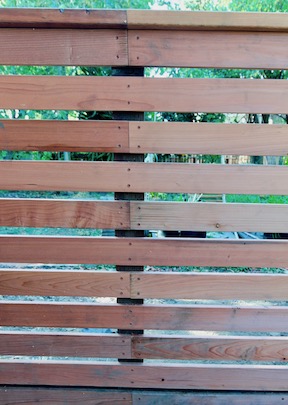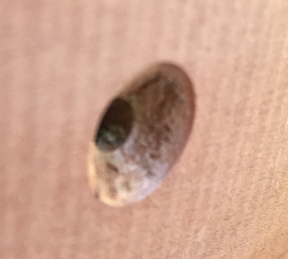Horizontal vs. Vertical Fence Boards
Vertical fence boards typically align along the top or bottom, or fit within a frame. They typically are installed touching or overlapping. When attaching the fence boards gravity tends to be more of a third hand. And alignment is usually fairly easy, both because the fence boards are usually resting on something when being attached (like my toe or a board or a 2x4), and because even if the fence is on a hill the fence boards themselves are still plumb (vertical).
Horizontal fences have none of the easy conveniences of building a fence with vertical fence boards. First, the fence boards must be installed end-to-end, which usually means they are longer than the normal 5’ or 6’ fence boards used in vertical fences. It isn’t uncommon to use fence boards that are wide enough to span 3 posts (one in the middle, one on each end of a fence board) and to alternate layer by layer so boards never meet above or below another pair of boards meeting.

The long boards shrink and expand with moisture. The shrinkage might be about 0.2% (https://www.fpl.fs.fed.us/documnts/pdf1931/koehl31a.pdf). I was using 14’ boards in the fence below and that works out to about 5/8”, which is a lot. So, if I built the fence with wet wood it might tear itself apart. I built this one with fairly dry wood from Truitt & White.

Gravity doesn’t help much when building a horizontal fence. I build jigs to make the job faster and more accurate; however, it is nowhere nearly as fast as adding vertical fence boards. Alignment is also much more critical with a horizontal fence. The margin for error in placement of the fence boards is very small, almost like building furniture. People notice horizontal boards that don’t align. People notice the vertical alignment of vertical fence boards much more than whether the tops and bottoms perfectly align. Vertical fence boards are not really very uniform, and even when you buy them all at the same time from the same pallet they are notorious for being a variety of lengths, widths and thicknesses, normally varying by at least 1/8”. When I cut fence boards to fit a fence they are precisely the right length. When I just attach them without cutting them they are definitely not within furniture tolerances.
A fence on a hill is always more challenging than a fence on flat land. With a vertical board fence it is easy to stair step the fence so each section is a bit higher or lower than the one before it. That can be much harder with a horizontal fence, especially if there is no retaining wall at the base of the fence. Will it be necessary to cut very long tapered fence boards to follow the hill? Will the fence boards themselves follow the slope of the hill? What if the hill doesn’t have a uniform slope? Vertical board fences can go up and down and up and down. A horizontal board fence will be more difficult, especially the longer the fence gets, because it is difficult to make a straight line over a long distance.
I used a laser level to build this horizontal fence at about 2 degrees. I also used a very taut string. People have been using taut string in construction since before the first castles were ever built, I’m sure.
Another complication with horizontal fences is that the long fence boards must generally be attached very close to the ends. If I were to nail the fence together then it would probably be OK, but I don’t nail fences together because it makes them unmaintainable. Fence maintenance is real. A maintainable fence means if there is a problem the parts come apart easily so parts can be replaced or the fence can be modified, such as to avoid a growing tree root that would deform the fence. Screws can be removed... well, the screws I use can be removed. I don’t use Phillips head screws (that look like a plus sign on the head). I use T25 Torx screws (star head) because they don’t strip out. They can be removed, even years later.
The problem is that if you use screws at the ends of the fence boards they’ll split. If not now then later; but, probably now. And, those 14’ long fence boards aren’t cheap. A split pretty much ruins one. The only way to avoid splitting the horizontal fence boards is to first countersink them and then drive the screw in, but not too deep. Even a hole with a countersink will not prevent a split if the screw goes in too far - below the level of the countersink.

Every hole has to be drilled with a countersink bit and then a screw has to be driven in to exactly the right depth. The fence above needed 275 countersunk screws, and many others that were not countersunk in other parts of the fence. That inevitably means more labor, and that means the fence costs more. The waste in the fence above was conspicuously low because the posts were just a bit under 7’ apart and the fence boards were 14’ long.
This horizontal fence was made with better redwood than most: Heart B. It is generally almost completely free of knots. I don’t think fence boards need to be knot-free, but my client wanted this kind of wood and it cost bit more than construction heart wood (con-heart).
For reference this is based on the actual fence built above. In fact some of the numbers were a bit different, but this is a representative example of the costs.
| Materials | cost each | number needed | extended cost | taxed cost |
| 4x4x12 Pressure Treated | $39.02 | 5.00 | $195.10 | $215.10 |
4x4x8 Pressure Treated | $26.79 | 1.00 | $26.79 | $29.54 |
1x4x14 S4S redwood, Heart B, mostly knot free | $24.04 | 55.00 | $1,322.20 | $1,457.73 |
1x4x12 S4S redwood, Heart B, mostly knot free | $20.60 | 3.00 | $61.80 | $68.13 |
1x4x8 S4S redwood, Heart B, mostly knot free | $13.73 | 1.00 | $13.73 | $15.14 |
2x6 S4S redwood/ft Heart B, mostly knot free | $61.45 | 5.00 | $307.25 | $338.74 |
2x8x16 Pressure Treated | $32.74 | 5.00 | $163.70 | $178.84 |
2x4x12 redwood S4s Heart B | $34.60 | 1.00 | $34.60 | $37.80 |
2x4x8 redwood S4s Heart B | $23.06 | 3.00 | $69.18 | $75.58 |
2x4x8 pressure treated (mid-span vertical ties@Home Depot) | $7.19 | 5.00 | $35.95 | $39.63 |
Quickrete 50lb from Home Depot | $5.25 | 15.00 | $78.75 | $86.03 |
Quickrete 50lb from Truitt & White | $8.79 | 3.00 | $26.37 | $28.81 |
3-1/2 in. Black Heavy Duty Tee Hinge | $6.87 | 2.00 | $13.74 | $15.15 |
Self-adjusting gate latch | $7.98 | 1.00 | $7.98 | $8.72 |
Fastner Pool | $40.00 | 1.00 | $40.00 | $40.00 |
| Actual Materials | $2,634.94 | |||
| Other costs | ||||
| Dump fees | $31.50 | |||
Actual Other Costs | $31.50 | $31.50 | ||
| Labor | rate | hours | cost | |
Day 1 | $65.00 | 5.00 | $325.00 | |
Day 2 | $65.00 | 4.00 | $260.00 | |
Day 3 | $65.00 | 3.75 | $243.75 | |
Day 4 | $65.00 | 4.25 | $276.25 | |
Day 5 | $65.00 | 5.75 | $373.75 | |
Day 6 | $65.00 | 5.25 | $341.25 | |
Day 7 | $65.00 | 4.75 | $308.75 | |
Day 8 | $65.00 | 5.50 | $357.50 | |
Day 9 | $65.00 | 5.25 | $341.25 | |
Day 10 | $65.00 | 2.33 | $151.45 | |
Day 11 | $65.00 | 5.00 | $325.00 | |
Actual Labor | 50.83 | $3,303.95 | $3,303.95 | |
| Actual Project Management Fee (15%) | $895.56 | |||
| Actual total project cost | $6,865.95 |
That was for a 70 foot fence. I don’t have a handy, comparable 70’ vertical fence to compare it with, but a 6-section least-cost fence looked like this:
| Materials | unit price | number needed | extended cost | taxed cost |
4x4x8 redwood | $24.42 | 7.00 | $170.94 | $188.46 |
2x4x8 redwood | $12.48 | 13.00 | $162.24 | $177.25 |
Redwood pickets | $4.45 | 71.00 | $315.95 | $345.18 |
Sika Post Mix | $10.47 | 7.00 | $73.29 | $80.80 |
Fastner pool | $10.00 | 1.00 | $10.00 | $10.00 |
| Actual Materials | $801.69 | |||
| Other costs | ||||
| Dump fees | $29.00 | |||
Actual Other Costs | $29.00 | $29.00 | ||
Labor | hourly rate | hours | cost | |
Day 1 | $65.00 | 5.25 | $341.25 | |
Day 2 | $65.00 | 5.00 | $325.00 | |
Day 3 | $65.00 | 6.00 | $390.00 | |
Day 4 | $65.00 | 6.00 | $390.00 | |
Day 5 | $65.00 | 1.00 | $65.00 | |
| Actual labor | 23.25 | $1,511.25 | $1,511.25 | |
| Project Management Fee (15%) | $351.29 | |||
| Final project cost | $2,693.23 |
Based on the above had the fence been 11 sections and not 6 sections it might have cost about $5,000. The extra effort of making the horizontal fence plus the cost of the higher quality wood cost an extra almost $2000.
